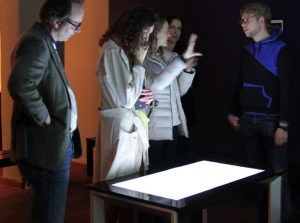 Many museums keep physical archives of artifacts and documents as well as digital repositories filled with directly related and meta information. Naturally, the number of objects filed away or being in remote locations surmounts the physical exhibition space. Many objects cannot be presented to the user and, thus, remain concealed. Hence, one of the challenges curators are facing is the selection and composition of artifacts and their combination with information into a congruent story line. Common practice dictates the creation to be limited to a set of curators working together. Thereby, special interests of visitors may often be neglected.
Many museums keep physical archives of artifacts and documents as well as digital repositories filled with directly related and meta information. Naturally, the number of objects filed away or being in remote locations surmounts the physical exhibition space. Many objects cannot be presented to the user and, thus, remain concealed. Hence, one of the challenges curators are facing is the selection and composition of artifacts and their combination with information into a congruent story line. Common practice dictates the creation to be limited to a set of curators working together. Thereby, special interests of visitors may often be neglected.
The growing availability of digital copies and related information of cultural heritage, such as Europeana, opens up possibilities to use new technologies to include digital content in museums. Showrooms can present a larger diversity of objects and virtual artifacts can include pieces from other museums. In contrast to physical exhibits, digital objects can be (re-)arranged without much effort. This allows the creation of a more dynamic design of showrooms. By ad-hoc arrangement of cultural heritage artifacts, visitors take on an active role and contribute to the exhibition design.
User Defined Exhibitions – Exploring Possibilities to Involve Visitors in the Design of Museum Exhibitions
When connecting the physical experience of museums and exhibitions with relevant digital information, creating engaging exhibitions is a challenge shared by both curators and interaction designers. There is a wealth of artifacts scattered across museums, their archives, and remote locations. Additionally, online repositories hold a multitude of digital cultural heritage content about these artifacts. The challenge of creating an exhibition lies in selecting related artifacts, combining them with available or proprietary information, and arranging them in a way that serves an intended story line. Common practice dictates the creation to be limited to a set of curators working together. We propose a visitor-centered design approach including a physical interaction space where visitors can browse archived objects and put together their own exhibitions with regards to a unique or given story line. We conducted an initial field study and report findings regarding the likes and dislikes of visitors.
Parallel Exhibits: Combining Physical and Virtual Exhibits
People have a special fascination for original physical objects, their texture, and visible history. However, the digitiza- tion of exhibits and the use of these data is a current challenge for museums. We believe that museums need to capitalize on the affordances of physical exhibits to help users navigate their more extensive virtual collections. Although lacking materiality, virtual objects have other advantages: They can easily be manipulated, rearranged, duplicated, and moved. This offers new op- portunities for visitors to engage with museum collections and the curatorial process in a creative way. In this paper, we propose a concept designed to make use of existing digital content in combination with physical exhibits in museums, which we call Parallel Exhibits.
Parallel Exhibits is a system that enables museum visitors to interact with traditional museum collections and virtual objects at the same time. It is an interactive exhibition space where visitors and curators enter a design dialogue mediated by tech- nology. Curators display a selection of physical objects and invite visitors to complete the exhibition with virtual objects from the museum’s collections or elsewhere. The ever-changing display can be augmented with digital text labels and messages. We implemented Parallel Exhibits as a web application, which bears the advantage of easily running the application on different platforms. We tested the system both in a museum, using an interactive table and a projection wall, and as part of an online sur- vey reaching a broader audience. In the field study we observed that visitors like to share their ideas and thoughts while using the table. The results of the online survey indicate that visitors like to contribute to exhibitions. In this paper, we describe the technical design of Parallel Exhibits, as well as the outcomes of the on-site study and online survey.